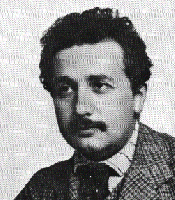

Albert Einstein
1879-1955


Born 1879 in Ulm, Wüttemberg (Germany). Degree from the ETH (Eidgenössische Technische Hochschule), Zürich, 1900. Bern patent office 1902-1907. Ph.D. 1905, "A new determination of molecular dimensions". Privatdozent, U. Bern, 1908. Professor, Universität Zürich, 1909; Prague, 1911; ETH, 1912; Berlin, 1914-1933; Institute for Advanced Study, 1933-55.
Worked on statistical mechanics, 1902-04, derived the first fluctuation-dissipation theorem, 1904. Light quantum hypothesis, theory of Brownian motion, methods for determining Avogadro's number, special theory of relativity, 1905. Gave the statistical basis for Planck's radiation law, developed Einstein theory of specific heats, 1906. Stated the equivalence principle, predicted gravitational red shifts, 1907. Also studied voltage fluctuations and the determination of Boltzmann's constant, relativistic thermodynamics, 1907. Analyzed fluctuations around equilibrium in black body radiation, stated wave-particle duality for photons, 1909. Theory of critical opalescence, 1910. Predicted bending of light by the sun quantitatively, 1911. General theory of relativity, precession of the perihelion of Mercury, bending of light (corrected), 1915. Radiation in quantum theory, spontaneous and induced radiation, Einstein A and B coefficients, 1916-17. Cosmology, cosmological constant, 1917. Nobel Prize for 1921, awarded 1922. Bose-Einstein statistics and condensation in the old quantum theory, wave-particle duality for matter, 1924-25. Worked largely on general relativity, unified field theories in later years.
For a scientific biography, see Abraham Pais, 'Subtle is the Lord', The Life and Science of Albert Einstein (Oxford, 1982).